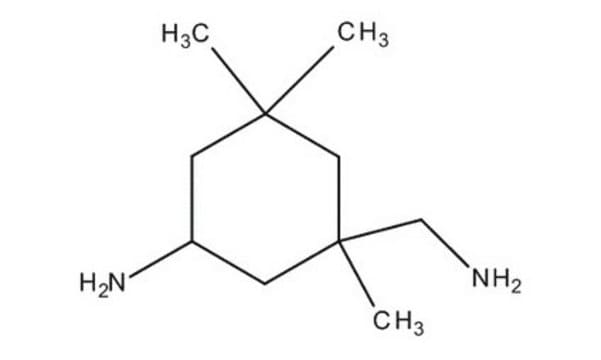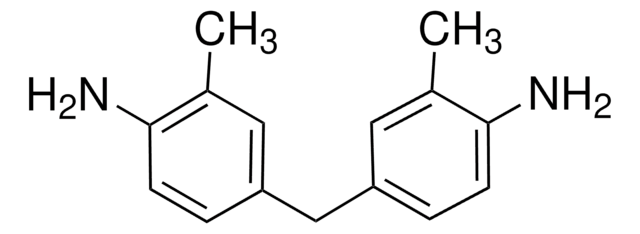369500
4,4′-Methylenebis(2-methylcyclohexylamine), mixture of isomers
99%
Synonym(s):
2,2′-Dimethyl-4,4′-methylenebis(cyclohexylamine), 3,3′-Dimethyl-4,4′-diaminodicyclohexylmethane, 4,4′-Diamino-3,3′-dimethyldicyclohexylmethane, Bis(3-methyl-4-aminocyclohexyl)methane, DMDC, Dimethyldicykan
About This Item
Recommended Products
assay
99%
form
liquid
refractive index
n20/D 1.499 (lit.)
bp
93-100 °C (lit.)
density
0.94 g/mL at 25 °C (lit.)
SMILES string
CC1CC(CCC1N)CC2CCC(N)C(C)C2
InChI
1S/C15H30N2/c1-10-7-12(3-5-14(10)16)9-13-4-6-15(17)11(2)8-13/h10-15H,3-9,16-17H2,1-2H3
InChI key
IGSBHTZEJMPDSZ-UHFFFAOYSA-N
Looking for similar products? Visit Product Comparison Guide
General description
Application
- in the synthesis of fully aliphatic polyimides
- in the synthesis of fully aliphatic polyimide-siloxanes (APISiO)
- to prepare epoxy resin with trimethylolpropane triglycidyl ether, used for the characterization of the structural organization in dragline silk by transmission X-ray microscopy (STXM).
signalword
Danger
hcodes
Hazard Classifications
Acute Tox. 2 Inhalation - Acute Tox. 3 Dermal - Acute Tox. 4 Oral - Aquatic Chronic 2 - Skin Corr. 1A
Storage Class
6.1A - Combustible acute toxic Cat. 1 and 2 / very toxic hazardous materials
wgk_germany
WGK 3
flash_point_f
343.4 °F - closed cup
flash_point_c
173 °C - closed cup
ppe
Faceshields, Gloves, Goggles, type ABEK (EN14387) respirator filter
Certificates of Analysis (COA)
Search for Certificates of Analysis (COA) by entering the products Lot/Batch Number. Lot and Batch Numbers can be found on a product’s label following the words ‘Lot’ or ‘Batch’.
Already Own This Product?
Find documentation for the products that you have recently purchased in the Document Library.
Customers Also Viewed
Our team of scientists has experience in all areas of research including Life Science, Material Science, Chemical Synthesis, Chromatography, Analytical and many others.
Contact Technical Service














![Trimethylolpropane tris[poly(propylene glycol), amine terminated] ether average Mn 440](/deepweb/assets/sigmaaldrich/product/structures/186/658/1b1d510a-705a-4bfd-b90a-9dec80d64467/640/1b1d510a-705a-4bfd-b90a-9dec80d64467.png)